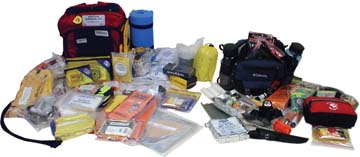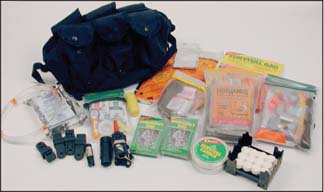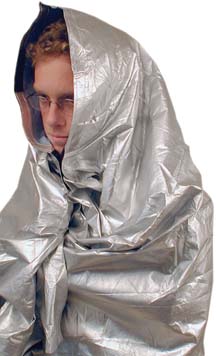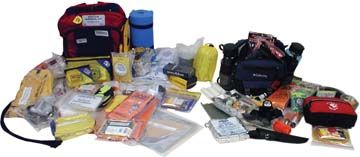
by Ben Barnard
Suppose youve ditched your airplane 30 miles offshore or ridden out an engine failure and settled into a tree-lined ridge in remote New Mexico. Now what? Are you prepared for the consequences? Look into your baggage compartment for the answer. If your idea of flotation equipment is a Styrofoam coffee cup, youre hardly alone. Very few aircraft owners take seriously the need for some kind of survival equipment. But there’s quite a lively cottage industry in marketing pre-packaged kits aimed at just this problem. You can spend as little as $50 or as much as $2500 for a kit intended to assure that a crash or ditching is a survivable event. If youre ambitious, you can even assemble your own, but thats not as easy as it might seem, nor will it necessarily be cheaper than one of the pre-packaged kits.The better way, we think, is to buy a basic kit, then add to it those items which will help you confront your personal survival demons.
Criteria
What should a good survival kit have? This is the classic desert island survival dilemma. Everyones must-have list will be different, but to be sure, there are basics every kit should have. These include, in order of importance, signaling equipment, basic first aid, shelter/clothing and simple tools to procure food and water, all in a small, lightweight package. If there’s space and budget, food and water are nice-to-haves, but don’t top the list of essentials.
Our opinions were guided by the SAR experts at the U.S. Coast Guard, who routinely put themselves in harms way and pluck hapless boaters and pilots from the drink or the woods. Lt. Cdr. Chris Day, the assistant chief at the Coast Guards National SAR School in Yorktown, Virginia, told us the well-dressed CG pilot carries a waterproof personal locator beacon (PLB), pen flares, day/night smoke flares, a signal mirror, a whistle, sea dye, a strobe light and matches.
Day told us that a 406 MHz, GPS-enabled PLB is the single most valuable survival item you can carry because it will allow SAR to rapidly locate you in an emergency. Day also carries a charged cell phone in a waterproof Ziploc bag which, even in a weak signal area, can continuously send an emergency text message.
During the day, nothing is more powerful than a signal mirror and at night, illumination of any kind will aid searchers. Night vision goggles will pick up the faintest light source, even the flint sparks from a dead lighter. Twelve-hour glow sticks and strobes provide sustained signals.
Based on Days recommendations, we think routine carry-it-always kits should tilt strongly toward multiple signaling and less toward long-term survival with accessories like fishing kits, water purification and elaborate gadgets.
If budget is limited, spend it on a PLB and a laser flare; hold the portable stove and knife. On the other hand, if the perceived risk is high-lots of overwater, mountain or remote area trips or natural paranoia, you’ll want as much gear as you afford and carry practically in the airplane. One caution: If the kit is so big that its competing for baggage space and is a constant candidate for being left behind, it should be downsized.
Day reminded us that the most powerful survival tool is free: an IFR flightplan on every flight. The Coast Guard says average duration between determining last known position and rescue for IFR flights is 13 hours, versus 37 hours for VFR flightplans and 42 hours when no flightplan is filed.
With the aforementioned criteria in mind, we obtained and evaluated a handful of commercial survival kits and compared contents lists on others that we didnt evaluate directly. Heres our report.
Inexpensive Kits
We looked at several lightweight, inexpensive kits for under $100. The Lifeline kit in a bottle comprises the lowest end of the spectrum. What can you really expect for $10? Housed in a buoyant, water-tight plastic bottle is a poncho, emergency blanket, flashlight with batteries and a blaze orange four-in-one tool that combines a compass, whistle, mirror and waterproof container, all attached to a lanyard. Not bad for $10, but for a little more money, you can assemble your own kit, opting for a smaller, higher quality flashlight, sunscreen and a larger signal mirror. There’s some extra room for food, a glow stick, a flare or a phone and a carabiner to clip the kit to your belt.
The $27 Pocket Survival Kit from Adventure Medical is the next step up. It was designed by Doug Ritter, whos we’ll known in the survival business for his Equipped to Survive foundation and Web site. He also designed a larger kit to be discussed later. (In the interest of full disclosure, Ritter is a former Aviation Consumer contributing editor who has written on survival topics for the magazine.) The Pocket Survival Kit comes in a waterproof pouch that does indeed fit in your pocket. It contains the basics for survival on land: compass, flint sparker and tinder, aluminum foil for water containment, whistle, mirror, fishing kit, scalpel blade and duct tape, among others. Its thorough instruction manual is probably the most valuable item in the kit. Beyond that, we would like a space blanket and additional signaling to improve this basic kit.
Survivor Industries is a Santa Barbara, California-based company that has specialized in packaging emergency food and water for 22 years. They also offer several survival kits. Howard Wallace, the companys president, recommended their Ark II kit for GA pilots. The $27 two-person kit is heavy on food and water and also contains a glow stick, matches, a candle, a Mylar emergency blanket, hand warmers and a first aid kit, all in a cardboard box which we think should be replaced with a waterproof bag. It should also be bolstered with more signaling devices, but for the price, we consider it a good value.
For $75, Survivor Industries offers an upgraded two-person kit that comes in a waterproof bag with more food, medical equipment and a flashlight.
We froze and then thawed several of the water pouches provided by Survivor Industries and other companies and found that the bladders withstood that test without rupturing. We also sampled the food, a super sweet concoction that tastes like shortbread. Its tasty but has an unpleasant, cloying aftertaste.
Aviation Survival Technologies offers the ideal overwater kit, a wearable fanny-pack type package. It costs $96 direct from ASTs Website, and the kit includes your tail number monogrammed on the pack. Assembled by former Coast Guard rescueman Randy Boone, the AST kit springs from the notion that in a ditching, whats on your person may be all you’ll have. This kit is small, unobtrusive and contains many useful items, with an emphasis on signaling, including two signal mirrors, a small flashlight, a strobe, glow sticks, a whistle and a reflective Mylar blanket.

It also comes with water pouches, first aid kit, nylon line and a multi-tool. The critical signaling equipment is attached to the pack with lanyards to avoid losing it. Boone told us the gear was chosen after his years of flying search patterns and contemplating what hed want if he was the victim.In his experience, severe sunburn is a common injury among survivors, so the kit has sunblock.
AST offers a modular land add- on kit for $32 that fits in the belt pack.Its contents are similar to Adventures Pocket Survival Pack, adding a wire saw, insect repellent, windproof/waterproof matches and fluorescent duct tape for marking trails. ASTs belt pack will also accommodate a PLB and they sell the McMurdo Fastfind Plus with internal GPS for $729.
The Survivor II from Red Fox ($69.99) is a 27-ounce kit that covers the basics. About 8 by 10 inches, its housed in a waterproof nylon case and includes flexi-sunglasses, a first aid kit, a wire saw, waterproof matches, a candle and food and water. What it most needs is additional signaling devices-a flashlight, chem lights or a strobe.
Mid-Priced Kits
The two-person Icarus from Fox Kits has a modular design similar to that of ASTs. Designed by Brian Fox, a former Army helicopter pilot and survival instructor, this kit is available in two major components, the base temperate module, which retails for $149.95 and the additional cold climate module for $59.95. This kit is aimed primarily at wilderness survival, although it does contain items that can be used for water rescue. At 8.5 pounds, this kit is light and small enough for easy egress.
The base kit covers all the essentials with regard to signaling, shelter, and first aid. The first aid kit is small and comprehensive and the Icarus is organized into several portable, waterproof plastic pouches. We found its red strobe to be less visible at a distance than the strobe in ASTs kit, which is the same as the one featured in the next kit we’ll discuss.
Fox recommends that when SAR is in sight, you tie some line to the chem lights and spin them in a circle over your head, increasing your visibility.We like the kits reflective blanket in addition to the blaze orange emergency bag, which can be rigged to make a shelter that also acts as a signal.
The cold module includes extra emergency bags, neck gaiters, a stove and warming packs. You can also buy modules to increase the basic contents to accommodate additional people. Specialty items such as a laser flare ($80) and a backpack with internal water bladder are add-on extras. We would trade the wimpish strobe for a laser flare with more candlepower, but for the price, this kit doesnt disappoint.
The Wilderness Aviator survival kit comes from Prepared Pilot, based in Salt Lake City, Utah. It also lives up to its name. The kit was designed by Rob Hunter, who flies frequently in the Utah backcountry. The 12 1/4-pound buoyant lumbar pack is full of useful, high-quality products for a protracted stay in the wild for two. In the signaling group, there’s a mirror, 12-hour glow sticks, a whistle, a hands-free headlamp, a mini-LED flashlight and a waterproof emergency strobe light. For shelter, there’s a space blanket with metal grommets, emergency bags, blankets and ponchos, plus a knife, water purification and fire-starting equipment. Two large water bottles are carried on either side of the pack.
The first aid kit is the most impressive feature. Its organized by type of injury in individually packaged units that are clearly labeled and come with instructions. The kit also includes a separate day pack created in conjunction with Adventure Medical that has all of the items in their Pocket Survival Kit, with the addition of water purification capability.
Hunter recommended bringing along a sleeping bag, which would be useful to keep an injured person warm. Although its on the heavy side, this $395 kit is we’ll thought out and contains practical, hand-picked items that will be useful in the bush. Prepared Pilot will also replace for free any items used during an emergency.
Worth mentioning is a mid-priced kit from Sportys Pilot Shop as an alternative to the Fox and Prepared Pilot. At $179.95, the Sportys kit weighs 6 pounds with empty canteens and its contained in a high-vis orange pack. Notable items are its emergency strobe and two-person tent. It has all of the components of the other kits, at a similar price. (Note: We compared contents but did not examine this kit.)
Last, Survivor Industries offers the $375 Canadian-Alaskan Aircraft Survivor Pak, which, at 31 pounds, is too heavy for light aircraft pilots not flying in that area. It has a comprehensive list of items that satisfy Canadian requirements, minus the guns, ammunition, snow shoes and blankets.
Megakit
If there’s a mother of all aviation survival kits, the Aeromedix/Doug Ritter Ultimate kit certainly qualifies. At $2450, with 226 individual items-some duplicated-this kit meets all of our criteria and then some. Its tilt is strongly toward surviving on land in remote areas where rescue may be days away. It has an excellent signaling package-laser flare, mirrors, optional PLB-but also impressive depth in long-term survival gear, including food and water for two people for 96 hours, a stove to cook and heat water, water purification and storage equipment, tools, shelter, plus a good instruction set on how to use all the gear. It even has a snow shovel.
For cold weather survival, this kit has bivy sacks, space blankets, pairs of hats and gloves. The kit has two excellent medical packages, one of which is a pocket-size version that we think would be useful for non-survival situations. All of the individual selections appear to be top quality. For example, the stove is made of titanium to save weight, the compass is a quality baseplate type and many of the items are nicely vacuumed packed, which saves space and reduces deterioration.
We were impressed with the thinking that obviously went into this kit and examining it in detail, we find no lapses worth mentioning. Well, one.There’s a degree of overkill that may make the kit unattractive for some buyers limited by weight and space. For instance, it has a total of four bladed tools when one good knife or multi-tool might be enough. Its also expensive, perhaps beyond the interest of a typical owner and weighs a bulky 22 pounds. In a tight baggage space, it may be the first thing left behind.

However, Aeromedix also offers a scaled-down version called the Essentials kit, also designed by Doug Ritter. It retails for $995, weighs 18 pounds and features less high-end equipment, but covers all the bases plus plenty of options. Of the comprehensive kits, the Aeromedix Ultimate and Essentials are hands down the most inclusive. A rifle and a real sleeping bag are all the extra gear youd need, even for cold, remote areas.
What to Buy?
Back to the desert island question. What do you want if youre stranded there? Thats easy: everything. That argues for buying the $2450 AeroMedix Ultimate kit and carving out a place in the baggage compartment, never compromising on leaving it behind.
But owning an airplane is ruled by compromise, so we think the Ultimate kit will be too large and too expensive for typical owners. Its perfect for that once-in-a-lifetime flight to Alaska or Hudson Bay, but too much for the way most owners use their airplanes.
Of the remaining kits, we thought the Icarus from Fox Kits-at about $210 with the cold weather add-ons-represented the best size/weight/equipment compromise and thus is the best value in a serious survival kit. The individual components arent as numerous as the AeroMedix Ultimate nor necessarily of the same quality, but at one tenth the cost, its more than adequate, especially for owners now carrying no survival gear at all. We would rate the Prepared Pilot kit as being just as practical, but its a second choice due to weight and size.
For small kits, we like ASTs overwater fanny pack. Its inexpensive, practical and, because you can wear it, there’s no chance it will be left behind. The pack has room for adding personal items and a PLB, an addition we think every owner should consider.
Also With This Article
“Products, Specs and Prices”
“Paranoia vs. Preparation”
-Ben Barnard is Aviation Consumers assistant editor.


